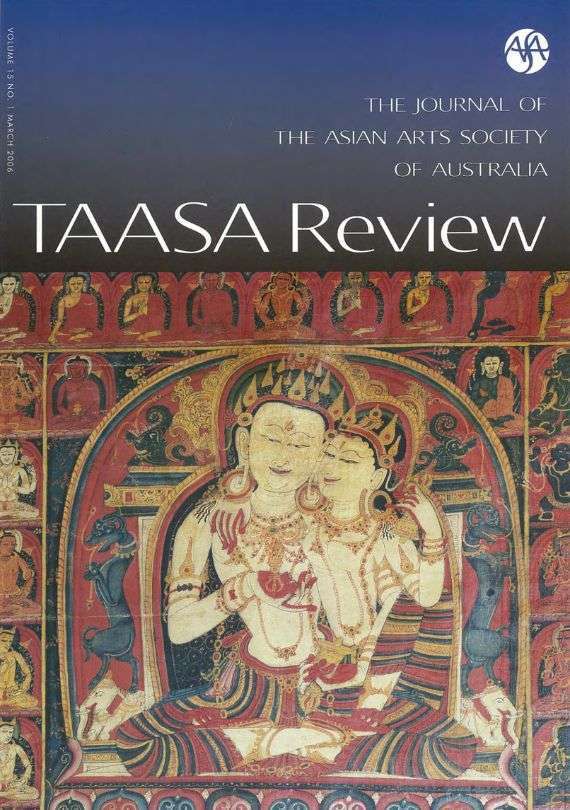TAASA Review Issues
March 2006
Vol: 15 Issue: 1
Tantra
Guest Editors: Jackie Menzies & Jim Masselos
Cover Image
Vajrasattva and Sattvavajri (detail), Tibet, C. 14th Century. Water based pigments on cotton cloth, 36.2 x 31.1cm. Zimmerman family collection, New York, Photo courtesy Zimmerman family. The couple represent the central Tantric Tenet of the union of wisdom (female) and compassion (male)
TAASA Members may log in to download a PDF copy of this issue as well as past TAASA Review issues back to 1992.

Editorial
The contributions to this issue address some of the multifarious practices and art-forms related to Tantra, an elusive term evoking varying responses. Mention the word before some people and they wince, shake their head and change the topic. For them Tantra evokes deviant sexual behaviour and unmentionable midnight activities in cremation grounds. Admittedly some Tantric ritual and practices can be deliberately confronting to society’s norms and conventional inhibitions, yet overwhelmingly Tantra is an inspiring body of spiritual texts, practices and art forms aimed at achieving insight into higher consciousness.
The word itself defies exact definition, yet is related to ‘thread’ as in a ‘thread of discourse’, with the texts of Tantra themselves referred to as ‘tantras’, as opposed to the sutras of non- Tantric streams of religious practice. Those spiritual practices and beliefs grouped together as Tantra arose in the early centuries CE in India, predominantly in the northeastern areas of Bihar and Bengal, from where they spread to Nepal, Tibet, and, to a lesser extent, parts of Southeast Asia. Absorbed by mainstream Hinduism and Buddhism, Tantra is defined by its emphasis on the worship of shakti (divine power which is personified as female). Fundamental to much of its teaching is the overcoming of polarities and the dissolution of perceived opposites such as male-female, macrocosmmicrocosm, and sacred-profane. As part of its belief in the merging of opposites, Tantra does not distinguish between the everyday world (samsara) and the experience of nirvana, as seen in the significance attached to the body, yoga, and ritual (puja), as discussed in some articles in this issue. The Tantric ideal of the uniting of male and female aspects of reality is seen in Hinduism with the couple Shiva- Shakti (personified as his wife Parvati). The same unity is seen in Buddhism in the ‘fathermother’ couples where the goddess Prajna (wisdom) is united in close embrace with her male partner Upaya (means or compassion). Tantric Buddhism (also known as Vajrayana) is better known in the West than its Hindu counterpart because of the Chinese invasion of Tibet and the forced flight of the Dalai Lama (in 1959), and the many lamas who then started teaching their previously secret traditions, translating Tantric texts, and opening a whole new sphere of spiritual practice to the West. Hindu Tantra awaits comparable attention. Some of the articles in this issue were initially presented at workshops on ‘the couple’ held at the Art Gallery of New South Wales as part of an Australian Research Council Linkage grant between the Gallery and the University of Sydney. The research conducted with this funding will also be manifest from October this year in the exhibition GODDESS: Divine Energy at the Art Gallery of New South Wales, which received development funding from the Gordon Darling Foundation. These articles, and others in the issue, are the result of fieldwork, research and travel by people who have been captivated by the vitality of spiritual traditions that continue today: traditions that still refuse categorisation, that defy the limitations of words, and that plumb the vast reserves of human psycho-spiritual intuitions.
Jackie Menzies, Guest Editor
Jackie is Head Curator of Asian Art at the Art Gallery of New South Wales, and co-guest editor of this issue with Jim Masselos.
Table of contents
3 EDITORIAL: TANTRA – Jackie Menzies
4 INTRODUCTION TO TANTRA SYMBOLISM IN TANTRA: THE SUBTLE BODY REVEALED – Swami Shankardev Saraswati
5 TANTRA: ACCESSING THE CREATIVE FORCE – Jayne Stevenson
6 SACRED SYMBOL, SECRET MEANING: THE KHATVANGA RITUAL STAFF IN BUDDHISM – Chaya Chandrasekhar
9 TANTRA: THE FIRST MAJOR EXHIBITION – Jim Masselos
10 THE TANTRIC MATRIX AT THE KAMAKHYA TEMPLE, ASSAM – Brenda Dobia
13 IN THE PUBLIC DOMAIN: A LION-HEADED GODDESS – Melanie Eastburn
14 KUMARI PUJA: VIRGIN GODDESS WORSHIP IN NEWAR TANTRIC RITUAL IN KATHMANDU VALLEY – Michael Allen
16 TRAVELLER’S CHOICE: GO GODDESS! – Olivia Prunster
18 THE ENIGMA OF BUDDHIST TANTRISM ON JAVA – LITERARY PIECES IN THE PUZZLE – Kate O’Brien
21 BEYOND BOLLYWOOD: INDIA’S TAMIL FILM INDUSTRY – Selvaraj Velayutham
22 ART AND RESPECT: A THANGKA WORKSHOP IN MELBOURNE – Ann Shaftel
24 EXHIBITION PREVIEW: FERTILE PLAYGROUND – Haema Sivanesan
25 TAASA’S END-OF-YEAR PARTIES, 2005
25 TAASA MEMBERS’ DIARY MARCH – MAY 2006
26 WHAT’S ON IN AUSTRALIA: MARCH–MAY 2006 – Compiled by Tina Burge
BECOME A MEMBER
To download a PDF copy of this issue as well as past TAASA Review issues, receive discounted entry to industry events and participate in exclusive study groups, join the TAASA Community today.
TAASA Review Issues
2024
2023
2022
2021
2020
2019
2018
2017
2016
2015
2014
2013
2012
2011
2010
2009
2008
2007
2006
2005
2004
2003
2002
2001
2000
1999
1998
1996
1995
1994
1993
1992
TAASA Review Issues
2024
2023
2022
2021
2020
2019
2018
2017
2016
2015
2014
2013
2012
2011
2010
2009
2008
2007
2006
2005
2004
2003
2002
2001
2000
1999
1998
1996
1995
1994
1993
1992